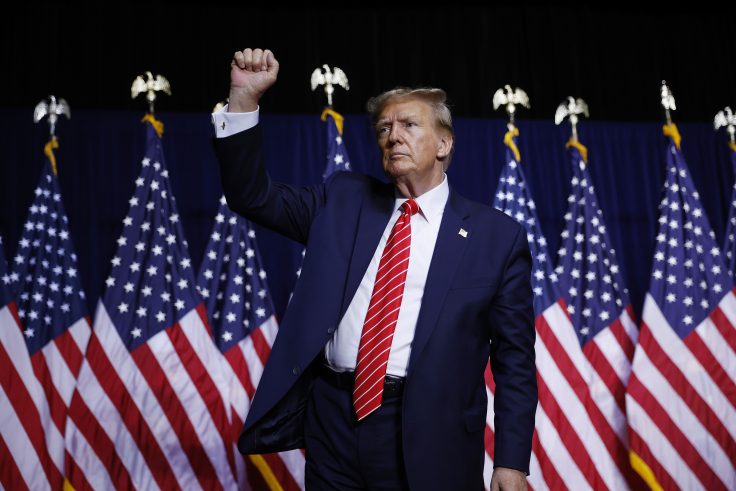If Donald Trump is elected president in November, he will have assembled a coalition unlike any Republican nominee in my lifetime.
For decades, GOP success has depended on support from college-educated white voters in the suburbs and non-college-educated white voters in manufacturing centers and rural areas. Republican candidates tried to maximize turnout among this electoral base, while adding a majority of independent voters to the GOP column. Presidents Nixon, Reagan, and the two Bushes used this strategy to great effect. Donald Trump did, too.
In 2016, at least. In 2020, according to the Fox News voter analysis, Trump lost white college-educated voters by 7 points and independent voters by 15 points. Joe Biden became president. Republicans did better in 2022, but they still lost white college-educated voters by 1 point and independents by 5 points.
One might assume, then, that a Trump-led Republican Party will continue to struggle for as long as it repels college-educated white voters and independents.
Yet Donald Trump isn't struggling. On the contrary: He's been leading President Biden for months. Independents have returned to Trump's column (though they don't seem happy about it). Trump's gains among non-college-educated, nonwhite voters have compensated for his continued problems with college-educated white voters.
This is a remarkable development. As recently as a few years ago, one might have been skeptical toward claims that educational attainment and ideology were becoming more significant than ethnicity and race. Such incredulity is no longer warranted. The realignment isn't just real. It's accelerating.
My colleague at the American Enterprise Institute Ruy Teixeira, as well as GOP pollster Patrick Ruffini, have storehouses of data that show Democrats losing non-college-educated minority voters—Hispanic voters in particular—to Republicans. Each new survey confirms their findings. The evidence is overwhelming.
The latest example: AEI researcher Nate Moore investigated Trump's growing favorability rating and found that the former president is more popular now than at any point since he left office. The source of this newfound popularity is minority voters. "While his support has ticked up among white and black Americans," Moore wrote this week in The Liberal Patriot, "the share of Hispanic Americans who have a favorable view of Trump has doubled over the last year from around 20 percent to 40 percent."
John Burn-Murdoch, chief data reporter for the Financial Times, analyzed election surveys going back to the 1950s. He found that the Democrats' advantage among nonwhite voters is at its lowest point since JFK was president. Black and Hispanic voters are matching their party preferences with their ideological preferences. Fewer self-identified conservative nonwhites vote Democratic for communal reasons.
"The migration we're seeing today is not so much natural Democrats becoming disillusioned," writes Burn-Murdoch, "but natural Republicans realising they've been voting for the wrong party." That has made Trump's GOP more diverse, more non-college, and more conservative.
Realignment proceeds in stages. Non-college-educated white voters were the first to abandon the Democrats, beginning in the late 1960s. Nixon's "hardhats" and the Reagan Democrats disliked their former party's positions on crime, busing, inflation, Vietnam, and the counterculture.
In the second stage, college-educated white voters in the suburbs began drifting away from the GOP in the 1990s. President Bill Clinton's soccer moms couldn't vote for Republican candidates affiliated with the Religious Right and the NRA. By 1998, journalist David Brooks was visiting well-heeled suburbs such as Winnetka, Ill., and finding that the rich Republicans were turning into Democrats.
Trump's election in 2016 marked the onset of the third stage. College-educated white voters left the GOP in droves, but the Republican Party remained competitive because Trump drew in large numbers of non-college-educated white voters spread throughout the country. The white working class felt a gut connection to Trump, who also began picking up support among Hispanic voters and black men—despite the media narrative that he and MAGA are racist.
Biden's presidency has catalyzed the educational realignment. Though "Joe from Scranton" presents himself as a champion of the working class, his spending, energy, and environmental policies have worsened living standards by contributing to rising prices and interest rates. The crisis on the southern border alarms voters concerned about security, civic disorder, and the rule of law. The world has become more dangerous, with Russia invading Ukraine, Iranian proxies wreaking havoc in the Middle East, and China and North Korea testing American willpower. State collapse in the Democratic Republic of Congo, Venezuela, and Haiti fuels migration and unrest. Biden will turn 82 in November. He doesn't look up to the job.
A realigned politics is unstable. As the Democrats become the party of college-educated, affluent insiders, they become removed from the world of non-college-educated workers who feel ignored or excluded from elite institutions and expert decision-making. The professionalization of print, digital, and broadcast media has estranged writers and talkers from most Americans. The highly educated, highly compensated denizens of Washington, D.C., and its surrounding counties have become a world unto themselves.
Those who live inside the bubble find it hard, if not impossible, to see outside it. There is less trust in a society where those who write the rules appear insulated or exempt from the rules. We aren't used to a politics where the party of the "Left" represents the establishment, and the party of the "Right" represents an insurgent movement against the settled way of doing things.
Poll results are not the equivalent of ballot returns. The Trump coalition may fail to materialize. Or it could show up in all the wrong places, winning Trump additional votes in blue cities in states he is fated to lose. And yet, when I look at Biden's consistently abysmal numbers, I can't help feeling that the country has written him off. The Democratic coalition has imploded. And the fourth stage of realignment—raucous, demotic, performative, over-the-top, transgressive, and potentially earth-shattering—is about to begin.
